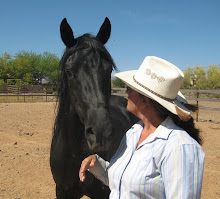Many people who are breeding/raising horses say they want to let the horse be a horse. They don't want to 'do/train' them until they're 2, 3 or 4. Yet, unless that foal is out with a herd, YOU are training him.
Leading the foal with or next to it's mother to the turn-out paddock and back, getting the halter on the horse and feeding IS training. Are you only looking at one side of the training? Is being nice a good way to train manners? WOULD THE OTHER HORSES IN THE HERD TREAT THE BUGGER THE WAY YOU ARE WHEN HE MISBEHAVES???? NO! No herd leader is going to let a foal shove his chest or shoulder into him or run ahead and then kick out at him, or rear up and swing his hooves at him. If you do, he's the power figure. This isn't rocket science yet people are reluctant to take care of this. A horse rearing and striking or kicking at you??? I hate when that happens.
If you never shove him away, or shoo him off you, or let him shoulder in to you, or step on you, you are training him to be aggressive and dominant. This will make your 'real training' that you're waiting years to do so much tougher.
Taking a moment to get the youngster to understand NOT in my space is so important and since you're there anyway, don't be lazy or misunderstand your motives in not taking care of it. You are not a leader if a 5 month old colt is making you move your feet. Giving direction to a movement is leadership in training and a must to avoid injury (mostly to you). Teaching the foal to give to pressure instead of learning that the person gives to pressure is imperative as the older it gets, the stronger and tougher it gets. The un-mannered foal grows into an un-manageble 5 year old who now breaks things, bends fencing, tears up the trailer, etc.
Take care of it as the herd leaders would and set yourself up for success later.
